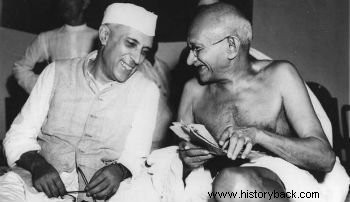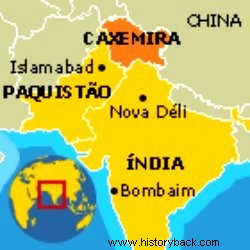The Independence of India was reached on August 15, 1947 after a long process of struggle.
The British left a country divided into two nations:India and Pakistan.
English colonization in India
India has always been an attraction for neighboring peoples. Its natural riches and the fertility of its soil attracted invaders.
Thousands of ethnic groups lived there, separated by different religions and languages, in addition to the caste system, which made society rigidly hierarchical.
With the arrival of the Muslim Mongol Empire and Europeans in the 16th century, the history of this subcontinent would change.
In 1600, representatives of the English East India Company arrived to trade with the Indians. A century later, they already had enclaves in Bombay, Madras and Calcutta.
The French also tried to occupy the territory, but were expelled by the British in 1755. Thus, the British annexed provinces of Punjab and Delhi until they declared themselves lords of India.
However, colonization was not peaceful, with resistance such as the Revolt of the Sepoys. It was not until 1877 that Queen Victoria was proclaimed Empress of the Indies.
Thus, complete colonization began with the importation of British institutions into Indian territory.
Colleges for both sexes, universities, postal and telegraph services, railways, aristocratic clubs, etc.
Likewise, the United Kingdom took their language to India, which gave them a common language, in a country where they have more than 200 dialects.
In fact, there would always be two Indian women during British domination:
- British-administered India from the capital, New Delhi;
- India of 565 principalities, where each one was dominated by a noble family that had complete control over its territory.
These maharajas, rajas and princes will admire English power. Thus, they grant the power of defense and foreign policy to the British, as long as they remain outside of their internal affairs.
Religious Diversity
In India, there are several religions such as Brahman, Jansenist, Buddhist, Sikh, Hindu and Muslim. These two were the majority and completely different from each other.
Muslims, who were the elite during the Mongol Empire, saw the British as a threat to their education system and their religion.
For their part, the Hindus accepted British education and became the mainstay of English domination, participating as officials in the colonial administration.
Read more :
- Ancient India
- Caste System in India
- Indian Culture
Process of Independence

Nehru and Gandhi:the two leaders of India's independence
However, the education received by this Hindu elite becomes a double-edged sword. The same Hindus who graduated from English universities will realize that they are serving the ruler and betraying the people to which they belong.
These university students founded the Indian National Congress in 1885 with the support of British liberals and will question the British occupation.
Leaders like Gandhi, a lawyer, appear, who will travel the country preaching a non-violent revolution against the British.
There were those who first want minimal self-determination and form part of the British Empire.
Others, like Nehru's and Gandhi's National Congress Party, realize that colonialism must end and India become an independent country.
Non-Violence Policy
After the First World War, the issues of colonial domination became clearer. Therefore, Gandhi leads three major anti-British campaigns:
- 1919 – General strike of various sectors such as transport and cleaning;
- 1920 and 1922 – Peaceful resistance:not collaborating with the British like not voting;
- 1930 and 1934 – civil disobedience:it consists in breaking the laws. The most famous of these is perhaps the Salt March where Gandhi, accompanied by his followers, collects salt from a salt pan and sells it, something that was forbidden to Indians, and is arrested.
For his part in these acts, Gandhi will spend several periods in prison along with other Indian political leaders. Among them, Nehru, who would become the prime minister of independent India, as well as founding a dynasty of politicians.
Later, in the middle of the Second World War, the rupture between the Indian people and the British reached its limit. The British government knew that India's independence would be a matter of time and decided to establish a negotiated exit.
The decolonization of India must be understood in the post-war context when colonialism came to be considered unacceptable.
For this, an English nobleman, Lord Louis Mountbatten is chosen as Viceroy of India in order to lead the process of emancipation.
Two major currents were formed:the first, defended by Gandhi, advocated a unitary India.
The second, claimed by Muslims, led by Muhammad Ali Jinnah, called for an independent state, which would be called Pakistan. Principalities that were independent would have to choose which country they would like to belong to.
Supported by the British, the second proposal won. This caused chaos in the country, as thousands of Muslims left their lands to head to the future country.
On the other hand, the Hindus did the same. It was not uncommon for the two columns of immigrants to find themselves walking in the opposite direction and the provocations ended in fights.
Officially, the British set the date of India's independence to 15 August. However, this day was considered by the Indians as not very propitious for such a relevant event. In this way, independence was proclaimed on the night of the 14th to the 15th of August.
Gandhi would end up assassinated by a radical Hindu in 1948 who did not agree with his defense of an India united to Muslims. In turn, Nehru was elected prime minister and was the longest-serving politician from 1947 to 1964.
Conclusion

Map of independent India:the disputed territory of Kashmir in orange
India today is one of the most populated countries on the planet. The population is diverse and divided into thousands of ethnicities, religions and languages.
The country still coexists with the problems left by the British, such as the issue of the border between India and Pakistan that dispute the Kashmir region. In the 1960s, China also joined the conflict.
In the 1970s, East Pakistan would be called Bangladesh.
See also:Conflict in Kashmir Read more :
- Imperialism in Asia
- Victorian Era
- Asia
- Brics
